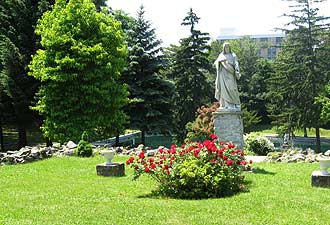
So today June 6
we celebrate the feast
of the Blessed Sacrament, the feast of the body
and blood of Christ.
So happy feast of the Blessed Sacrament
and we know that the Blessed Sacrament
is very much linked to the mystery of the Sacred Heart.
We know that Marguerite-Marie had
the 3 great apparitions, always,
while she was in adoration
before the Blessed Sacrament exposed.
We continue our meditation,
so from the first quote
we haven’t finished
commenting on it yet.
Not a bone will be broken.
So yesterday we saw it was,
an extract from Psalm 33,
no bones will be broken for him,
that it was also
what was said of the paschal lamb
in exodus 12, verse 46.
No bones will be broken for him,
but now
it’s a matter of making a synthesis
there, so you have noticed.
On the one hand, we have a righteous,
unjustly persecuted,
suffering servant. On the other side,
the slaughtered paschal lamb,
whose bones are not broken.
No bones. On the 2 sides
How to make the synthesis all the same
to arrive at designating Jesus?
There is already a synthesis taking place.
In the Old Testament.
This is the very famous
passage from Isaiah chapter 53
on the suffering servant.
This passage that we read
during Holy Week
before the Triduum.
And so, we are told
that the suffering servant
who takes upon himself all our sins
while he, he is innocent,
lets himself be led to the slaughterhouse
like a lamb.
You see there was
an identification there
between the suffering,
persecuted servant and the Lamb.
We also add, like a dumb sheep,
he has no reply to his mouth.
He lets himself be led to the slaughterhouse.
So there, already, it
is something extremely important.
Already, Isaiah seems to
make an identification
between the paschal lamb
that is sacrificed for the Passover
in the Jewish Passover,
and the suffering servant,
who will give his life for the multitude.
While he is not guilty of anything.
And now we just
have to take one more step,
suddenly,
John heard,
what John the Baptist
spoke as a word.
As Jesus arrives at the Jordan River,
when John the Baptist sees Jesus,
what does he say?
In the Gospel of John 1
here is the Lamb of God
who takes away the sin of the world.
It is John the Baptist who identifies
the suffering servant,
(he sees in Jesus truly the righteous)
but who is going to be condemned,
and who will therefore become the
true paschal lamb.
The lamb slain for the salvation of all.
So he said, here is the Lamb of God.
Who takes away the sin of the world.
So suddenly, later,
when John will have contemplated
and meditated on Jesus on the cross,
he will have no difficulty
in remembering
his words of John the Baptist and said:
here it is now, it is accomplished.
The suffering servant allowed himself to be
led like a lamb to the slaughterhouse
and thus fulfilled both
the prophecies on the suffering
servant of Isaiah 53,
and the symbolism of the paschal lamb of Exodus 12.
And suddenly, this theme of the lamb,
it is not at all
astonishing that Jean is impregnated with it.
Because, if we consider that
John is also
the author of the Apocalypse.
So he will come back to this theme
of the lamb, the lamb slaughtered, slain,
but ultimately victorious, victorious,
who sits with God on the throne
in Heavenly Jerusalem.
tomorrow
we will tackle something else,
prepare the chapter of 13 of Saint John.
Source: Fr. Kars, https://www.sacrecoeur-paray.org/enseignements/6-juin/